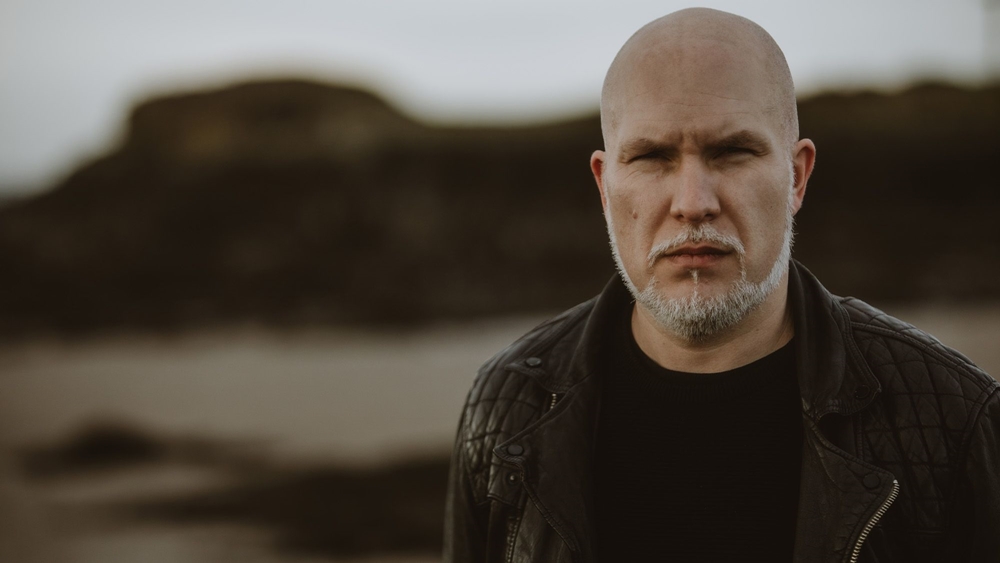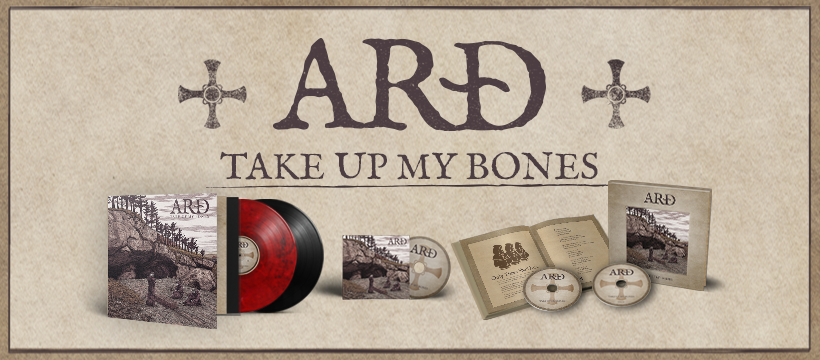Northumbrian doom monks ARÐ are releasing their acclaimed debut full-length “Take Up My Bones” today, February 18.
ARÐ comment: “The journey to get this music out for others to hear has been a long one, but I could not be happier with how the album both looks and sounds in its final form”, writes musical and lyrical mastermind Mark Deeks.
“Prophecy understood from the beginning the need for attention to detail in every aspect of the physical manifestation of the hymns of Arð. The overwhelming reaction that we have already received shows that it was a process well worth undertaking. Please watch this space as we will soon announce a beautiful and tasty collaboration.”

ARÐ are of Northumbria. The band’s name is taken from an Old English word meaning “native land” in the dialect of the Anglian Kingdom of Northumbria. The concept behind the debut album “Take Up My Bones” from this insular doom metal project revolves around the legendary relics of the famous Northumbrian Saint Cuthbert (634–687) and their long journey.
The theme that has inspired mastermind Mark Deeks would easily fit into the black metal mold were it not for the holy man. This particularly harsh style has a long history in the wake of BATHORY’s pioneering works of being deeply rooted in the native traditions of their homelands. Countless Norwegian, Icelandic, and Swedish bands referring to the myths, sagas, and history of the Viking age offer a strong case in point.

Yet ARÐ transfer this artistic quest for heritage and identity upon a solid doom foundation, which in itself constitutes a new approach. And while the topics of prophecy, funeral, and hermitage related to St. Cuthbert are quite suitable for the doom genre, which often deals with death, melancholy, and sorrow, the soul-search through history and time on “Take Up My Bones” reaches far deeper than mere gothic ornamentation.
While the early medieval histories of Europe’s Scandinavian North and neighboring Scotland have been rediscovered, glorified, and blended with nationalistic politics during and following the 19th-century romantic movement, Northumbria’s past has received surprisingly little attention – despite this beautiful land between two seas having been a flowering cultural focal point for centuries; with vectors of influence incoming and outgoing from and to all over Europe and beyond.
The early medieval Anglo-Saxon kingdom of Northumbria that inspired ARÐ was far larger than the historic English county Northumberland implies. After the dynastic fusion of the older kingdoms of Deira and Mercia in the early seventh century, Northumbria reached its greatest expansion in the east from the River Humber, from which it took its name (“North of the Humber”) and the river Mersey in the west of what is now Northern England. Its northern territories included the southern half of Galloway and reached westwards to the southern shore of the Firth of Forth above Edinburgh, which later in medieval times became part of the kingdom of Scotland.
Before the Germanic warriors arrived, at first as a part of the Roman armies and later as conquerors, the Romans had subjugated the local population of Brittonic Votadini, speakers of a Celtic language. Rome’s legions brought units from across the empire as far away as archers from Syria to what is now the north of England. The name of the Votadini resounds in the Old Welsh poem “Y Gododdin”, which describes a battle between the Britons and the Saxon invaders of these lands that the latter named Northumbria. This epic poem might contain the earliest reference to a pseudo-historic character whom the Normans centuries later called King Arthur in the lines: “He fed black ravens on the rampart of a fortress – Though he was no Arthur”.

Yet the Romans had left another legacy that firmly took root in neighboring Ireland and soon began to affect the new Germanic rulers of these northern lands as well as ultimately inspiring the tale of “Take Up My Bones”: Christianity. The early medieval coastal monasteries of Whithorn in the west and Lindisfarne in the east bear witness to this transition. It is in Lindisfarne on Holy Island in the time after the devastating Viking attack from across the sea in the year 793 where the story of the remains of St. Cuthbert begins: a 200-year journey that saw the saint’s remains finally reburied in the cathedral of Durham. The legends and mystery of the translation of the saint’s relics such as the refusal of his coffin to be moved or the lack of corruption upon his corpse after decades shape the core of this conceptual musical tale.
With crushing glacial-paced doom, monastic sounding chants and choirs, and sorrowful yet epic melodies, ARÐ have found the perfect musical expression to tell a tale of their homelands.
Mark Deeks, who earned his Ph.D. in Philosophy on the topic of “National Identity in Northern and Eastern European Heavy Metal”, is also a member of leading UK black metal stalwarts WINTERFYLLETH and keeps himself busy as a musical director, arranger, piano coach, and conductor as well as the best selling author. On “Take Up My Bones”, Mark is supported by WOLCENSMEN mastermind Dan Capp on guitars and backing vocals. He is also joined by ATAVIST drummer Callum Cox, and a spellbinding performance from cellist Jo Quail (MY DYING BRIDE et al.) delivers the coup de grace.
With “Take Up My Bones”, ARÐ offer deep and fascinating doom metal that musically stands out with its monastic soundscapes while also masterfully telling a story rooted in a magical place that has been called home by many cultures, which shaped a modern identity that builds on the rich heritage of centuries.
You can pre-order “Take Up My Bones”, HERE.

Follow ARÐ on:
Facebook | Instagram
Artwork: (c) Gabriel Danilchik (Archangel Impressions)
ARÐ logo design: (c) Dan Capp
Layout: (c) Łukasz Jaszak
Photo: (c) Gavin Forster



